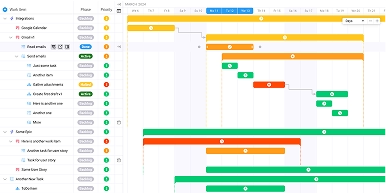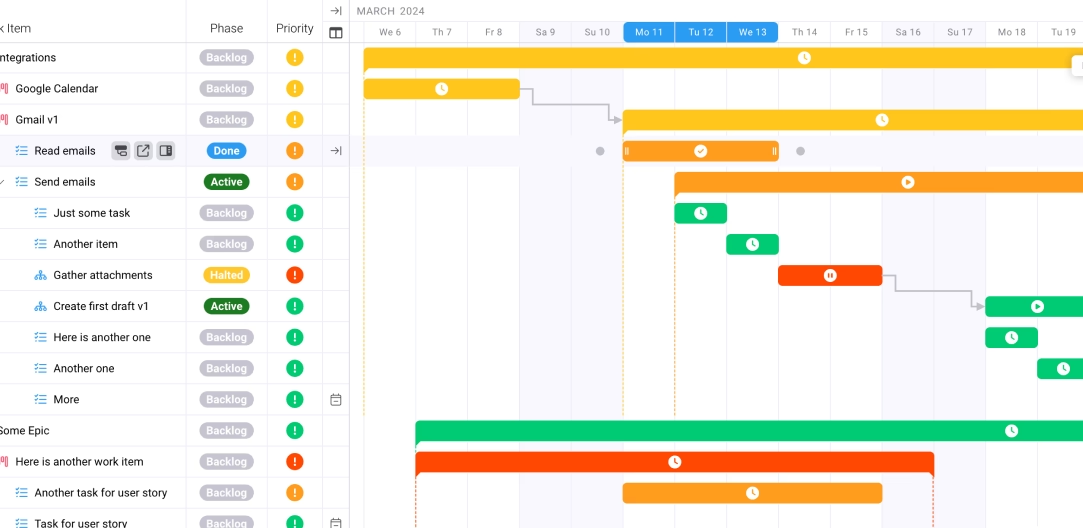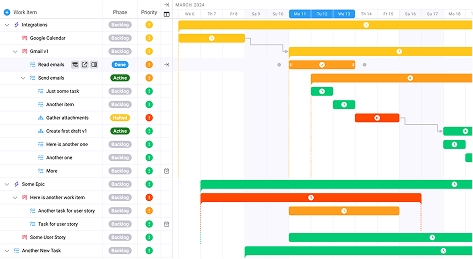
Project Management for Creative Teams: Design, Content & Beyond
Key takeaways:
- Structured project management life cycle implementation delivers measurable results: Organizations with project management maturity in scope, budget, schedule, and project performance measurement have a project success rate of 92% compared to significantly lower rates for unstructured approaches
- The five phases provide comprehensive project coverage: Each phase serves a critical purpose in transforming project concepts into successful deliverables through systematic planning and execution
- Proper phase management reduces risk and improves efficiency: Organizations implementing project management best practices see 2.5x higher success rates and save 28 times more money than those without standardized approaches
- Technology integration enhances phase execution: Modern project management software and methodologies enable more effective phase transitions and stakeholder collaboration
The project management life cycle serves as the strategic backbone for successful project delivery, yet only 35% of projects are completed successfully according to Harvard Business Review research. Understanding and implementing the five distinct phases of the project management life cycle can dramatically improve your organization’s project success rates while maximizing resource efficiency and stakeholder satisfaction.
The Current Challenge – Why Projects Fail Without Proper Life Cycle Management
Modern organizations face unprecedented complexity in project delivery, yet many continue operating without structured project management life cycle approaches. The statistics reveal a concerning reality: scope creep causes more than half of projects to go over budget, while timeline overruns and resource misallocation plague countless initiatives.
The root causes of project failure typically stem from inadequate planning during early phases, insufficient stakeholder engagement throughout the project management life cycle, and lack of systematic monitoring and control mechanisms. Without proper phase management, projects become reactive rather than proactive, leading to crisis management scenarios that consume resources and damage stakeholder relationships.
Organizations that recognize these challenges and implement comprehensive project management life cycle frameworks position themselves for sustainable competitive advantages. The global project management software industry size was nearly $11.96 Billion in 2021 and is set to increase to about $15.08 Billion by 2030, reflecting growing organizational investment in systematic project management approaches.
The Strategic Framework – Understanding the Project Management Life Cycle
The project management life cycle is a step-by-step framework of best practices used to shepherd a project from initiation to conclusion. This systematic approach provides structure and predictability to project execution while maintaining flexibility for adaptation and improvement throughout the project journey.
Projects have a definitive lifespan, during which they undergo the 5 phases of the project life cycle: initiation, planning, execution, monitoring and controlling, and closure. Each phase builds upon the previous one while preparing the foundation for subsequent phases, creating a logical progression from concept to completion.
The strategic value of the project management life cycle extends beyond individual project success to encompass organizational capability development, stakeholder relationship management, and continuous improvement processes. Experience with clients over the years in a wide variety of industries and projects have indicated that an effective project management process should contain nine basic elements, or best practices, with the five-phase structure serving as the foundation for implementing these best practices systematically.
Implementation Tactics – Mastering the Five Phases of Project Management
Phase 1: Project Initiation – Building the Foundation for Success
The initiation phase represents the critical starting point where project concepts transform into actionable initiatives with clear business justification and stakeholder commitment. This phase involves developing comprehensive business cases that demonstrate project value, align with organizational objectives, and secure necessary resources and support for successful execution.
Effective initiation requires thorough stakeholder identification and engagement to ensure all relevant parties understand project objectives and commit to supporting successful outcomes. The project charter serves as the foundational document that formally authorizes the project while establishing scope boundaries, success criteria, and high-level resource requirements.
Project managers must conduct feasibility studies that assess technical, financial, and operational viability while identifying potential risks and constraints that could impact project success. Clear documentation of project deliverables, requirements, and specifications keeps everyone aligned and provides a reference point for project teams throughout the entire project management life cycle.
Phase 2: Project Planning – Creating the Roadmap for Execution
The planning phase transforms high-level project concepts into detailed execution roadmaps that guide team activities and resource allocation throughout the project management life cycle. This comprehensive phase involves creating work breakdown structures, developing realistic schedules, and establishing quality standards that ensure deliverable excellence.
Resource planning becomes critical during this phase, requiring careful assessment of skill requirements, capacity constraints, and availability patterns. Modern organizations leverage project management platforms that integrate planning capabilities with resource planning and time tracking functionality for comprehensive project oversight.
Risk management planning establishes proactive approaches for identifying, assessing, and mitigating potential threats to project success while developing contingency plans for addressing unexpected challenges. Communication planning defines stakeholder engagement protocols and reporting mechanisms that maintain transparency and alignment throughout project execution.
Phase 3: Project Execution – Transforming Plans into Reality
The execution phase represents the core work period where project teams implement planned activities to create project deliverables according to established specifications and quality standards. This phase requires strong leadership, effective communication, and systematic coordination to maintain momentum while adapting to emerging challenges and opportunities.
Team management becomes paramount during execution, involving task assignment, progress monitoring, and performance optimization to ensure efficient resource utilization. Research from MIT indicates that highly skilled workers who use generative AI within the bounds of its capabilities can actually improve their performance by as much as 40%, highlighting opportunities for technology-enhanced execution processes.
Quality assurance activities must be integrated throughout execution to prevent defects and ensure deliverables meet stakeholder expectations. Stakeholder communication intensifies during this phase, requiring regular updates, feedback collection, and issue resolution to maintain positive relationships and project support.
Phase 4: Monitoring and Controlling – Ensuring Project Success
The monitoring and controlling phase operates concurrently with execution to provide continuous oversight and corrective action capabilities throughout the project management life cycle. This phase involves systematic performance measurement, variance analysis, and change management to keep projects aligned with approved plans and success criteria.
Performance monitoring requires comprehensive tracking of schedule adherence, budget utilization, quality metrics, and stakeholder satisfaction indicators. Modern project management software provides real-time dashboards and automated reporting capabilities that enable proactive issue identification and resolution.
Change control processes become essential for managing scope modifications, requirement updates, and resource adjustments while maintaining project integrity and stakeholder agreement. Billing and financial tracking systems provide visibility into cost performance and budget adherence throughout project execution.
Phase 5: Project Closure – Capturing Value and Learning
The closure phase ensures systematic project completion while capturing lessons learned and transitioning deliverables to operational use. This final phase involves formal deliverable acceptance, resource release, and documentation of project outcomes for future reference and organizational learning.
Administrative closure activities include contract completion, vendor payments, and final reporting that demonstrates project value delivery and stakeholder satisfaction. Knowledge transfer processes ensure that project insights and expertise benefit future initiatives while building organizational capability and maturity.
Client portal systems facilitate final deliverable presentation and acceptance while maintaining professional relationships that support future business opportunities. Post-project reviews provide valuable feedback for continuous improvement of project management life cycle processes.
Measuring Success – KPIs and Metrics That Drive Improvement
Effective project management life cycle implementation requires comprehensive measurement systems that track performance across multiple dimensions while providing actionable insights for continuous improvement. Primary success indicators include project completion rates, schedule adherence percentages, budget performance metrics, and stakeholder satisfaction scores that demonstrate overall project management effectiveness.
Leading indicators help predict future performance and identify potential issues before they impact project outcomes. These metrics include milestone achievement rates, resource utilization efficiency, risk assessment accuracy, and stakeholder engagement levels that enable proactive management interventions.
Quality metrics assess deliverable excellence and stakeholder value creation through defect rates, rework percentages, and user acceptance scores. Financial performance indicators measure cost efficiency, resource optimization, and return on investment to demonstrate business value delivery throughout the project management life cycle.
Advanced measurement systems incorporate benchmarking capabilities that compare organizational performance against industry standards and best practices. This comparative analysis reveals improvement opportunities while validating the effectiveness of project management life cycle investments and implementations.
Future Considerations – Emerging Trends in Project Management Life Cycle
The project management life cycle continues evolving in response to technological advancement, changing workforce expectations, and increasing business complexity. Artificial intelligence and automation technologies offer significant opportunities for enhancing phase execution while improving efficiency and decision-making capabilities.
Hybrid project management methodologies combine traditional life cycle structure with agile execution practices to balance predictability with adaptability. These approaches enable organizations to maintain systematic planning while responding rapidly to changing requirements and market conditions.
Sustainability considerations are becoming integral to project management life cycle planning as organizations focus on environmental impact, social responsibility, and governance requirements. Future projects must balance traditional success criteria with broader stakeholder value creation and long-term sustainability objectives.
Remote and distributed team management continues reshaping project execution approaches while requiring enhanced collaboration technologies and communication protocols. The project management life cycle must accommodate virtual team dynamics while maintaining effectiveness and stakeholder engagement across geographical and cultural boundaries.
The project management life cycle provides the essential framework for transforming project concepts into successful business outcomes through systematic planning, execution, and control processes. Organizations that master the five phases of initiation, planning, execution, monitoring and controlling, and closure achieve significantly higher success rates while building sustainable competitive advantages.
Success in implementing the project management life cycle requires commitment to systematic approaches, investment in appropriate technologies and training, and continuous improvement based on performance measurement and stakeholder feedback. Modern project managers must balance traditional life cycle principles with emerging technologies and methodologies to optimize project outcomes in increasingly complex business environments.
The data clearly demonstrates that structured project management life cycle approaches deliver measurable benefits in terms of success rates, resource efficiency, and stakeholder satisfaction. Organizations that embrace comprehensive project management life cycle frameworks while adapting to emerging trends will be best positioned for sustained project management excellence and business growth.
Frequently Asked Questions
What are the 5 phases of the project management life cycle?
The five phases are initiation, planning, execution, monitoring and controlling, and closure. Each phase serves a specific purpose in guiding projects from concept to completion while ensuring systematic management and stakeholder satisfaction.
How long should each phase of the project management life cycle take?
Phase duration varies significantly based on project complexity, scope, and organizational requirements. Initiation and closure are typically shorter phases, while planning and execution usually consume the majority of project time and resources.
Can project management life cycle phases overlap?
Yes, phases often overlap in practice, particularly monitoring and controlling which occurs concurrently with execution. Some organizations also begin preliminary planning activities during late initiation stages to accelerate project momentum.
What tools are essential for managing the project management life cycle?
Comprehensive project management platforms that integrate planning, execution, monitoring, and reporting capabilities are essential. Key features include resource planning, time tracking, collaboration tools, and performance dashboards.
How does the project management life cycle differ from agile methodologies?
Traditional life cycle approaches emphasize comprehensive upfront planning and sequential phase execution, while agile methods use iterative cycles with continuous stakeholder feedback. Hybrid approaches combine both methodologies for optimal flexibility and control.
What are the most common reasons for project management life cycle failures?
Common failure factors include inadequate stakeholder engagement during initiation, insufficient planning detail, poor communication throughout execution, ineffective monitoring and control processes, and incomplete closure activities that fail to capture lessons learned.









